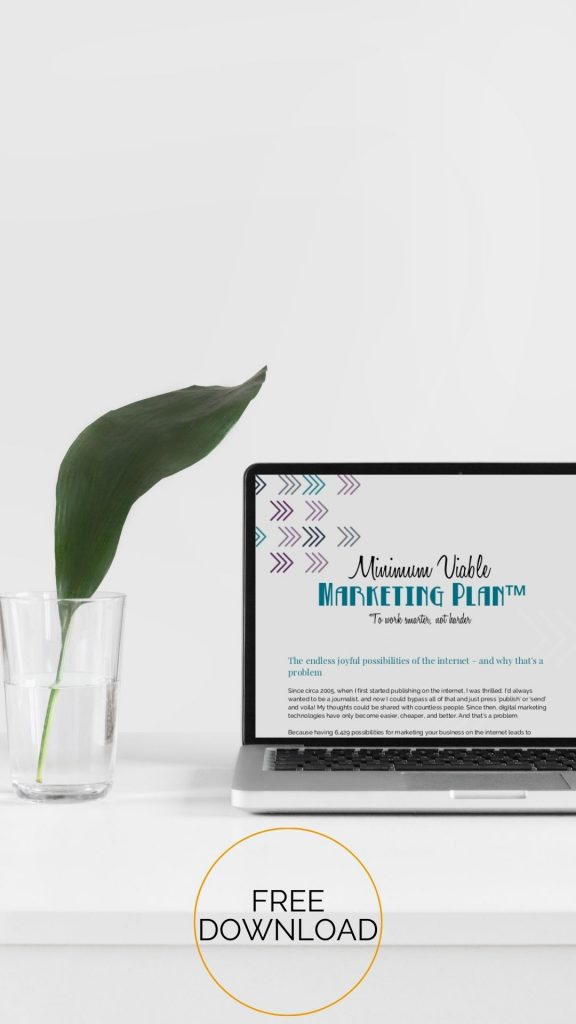I love watching people sell from stage. I love the dramatic stagecraft, the structure of their messaging, rhythm and repetition, the emotional arc, and tiny details that cue particular responses in the audience. I love it so much that I tried it myself.
Several years ago, I sold a low-priced half-day business event in Sydney, Melbourne, Brisbane and Adelaide, that was designed to sell my larger Hustle & Heart group program.
It was a flop.
I didn’t sell the program. I felt terribly self-conscious and unnatural. I didn’t have the infrastructure – let alone the marketing budget – to make this model work.
I didn’t make any money but I did break even. Two of the participants that came along to the Melbourne event were speaker’s agents and approached afterward to represent me and both of those people have gone on to purchase my courses and programs, so – like all outreach – it wasn’t a total failure.
But it’s not something that I will do again (ever!).
I share this story because what works for one business owner doesn’t necessarily work for another – not by a long shot.
But there are certain digital marketing trends in 2022 that I’ve either implemented or am about to implement – that I’m honing my focus on in 2023. These trends are highly effective or have loads of promise for my business brand, reach and visibility, lead generation and, ultimately, sales.
As always, I’ll be adding some things to my ‘stop doing’ list, to help make space for good things to come.
Online summits
Online summits are similar to conferences, whereby speakers present on their topic of expertise and participants attend. Online summits are often free and frequently have a ‘VIP upgrade’ option for participants who want to accelerate their learning.
Speakers aren’t typically live but rather, pre-recorded, though online summits take place at particular times.
As a speaker, you get paid through affiliate commissions to promote the event, plus you grow your email list and social media communities. It is a brilliant opportunity to get in front of other people’s audiences
I’ve been participating in several this year, which have seen my email list and social media communities substantially expanded. And some participants have moved quickly into becoming new paying clients. I’ll be improving and doubling down on this strategy into 2023.
Stop doing:
Paying to give away IP. It sounds a little nuts when I put it like that, but it’s not uncommon for business owners to be solicited to pay to give away their best ideas. Many conferences are run on the goodwill of the speakers, which can easily dissolve into a pitch fest of discombobulated, contradictory speakers. Although I have 11 years’ experience as a speaker, I’m often approached to speak for free or requested to pay for a ticket to the event. That’s a hard no.
Everything is up for negotiation. I’ve often been paid to speak at conferences that initially had “no budget” for speakers.
TikTok marketing
I registered for TikTok a couple of years ago and have barely posted anything, but the stats are screaming at me – including that the average TikTok user spends 89 minutes per day on the app (according to Music Business Worldwide), 71% of TikTok users say the app has a bigger impact on their lives than other apps they use, and 79% say it inspires them to do new things in real life. (See TikTok trends.)
In addition, the TikTok algorithm favours content over other factors, such as past popularity, evident in the Instagram algorithm. Which means, if you’re prepared to be courageously creative, your content will be judged on its merit, not how ‘internet famous’ you are, so you stand a much better chance of high reach and visibility.
Stop doing:
Having created regular content for 11 years now, I’m reusing, reducing and recycling. Which means creating an efficient archive of information that I can copy and paste at a cinch. Repetition is one of the hallmarks of retention. You build a brand by repetition over time. It’s one of the hardest things to do because human beings are infinitely creative, easily bored, and we love to complicate things.
Instagram Reels
I’ve been doing live social video since as long as it became an option but I’m doubling down on this. Since Instagram announced that it’s becoming a ‘video first’ platform (LINK NEEDED), the algorithm is giving more visibility and reach to Reels and Lives, and far less to image posts.
Stop doing:
I used to post five static posts per week to Instagram, and three to Facebook. I’m now reducing this to one post on Instagram and none to Facebook. If I post on my Facebook page now, it’s either a reshare, or a live video, or posted directly from Instagram, which saves a lot of time and effort.
Email segmentation
Okay, so this one isn’t new, but it’s amazing how simple and effective it is. My business runs on email segmentation. People opt-in to different freebies (such as my Next Best Step diagnostic or ‘Leading with your Social Mission’ video masterclass) as well as register their interest in different courses and programs.
My main method to sell my courses and programs is through emailing these interest list segments. This is low-effort, no-cost and highly effective. In fact, email continues to outperform every other digital channel year-on-year – delivering a 3600% return on investment (ie: for every dollar you spend on your email marketing, you can expect a return of $36).
Stop doing:
Obsessing about unsubscribes. The nature of email marketing has changed. We are all receiving more emails than ever, plus we’re often following our favourite businesses on several different social media channels. Over the last several years, I’ve noticed particular people subscribing and unsubscribing in cycles, as it suits them. This is not something to worry about. It is simply enabling people to take control on the information that’s coming at them – surely a good thing for our poor addled brains.
LinkedIn realness
Again, I’ve been on LinkedIn for a number of years and it hasn’t been my favourite. In fact, I may have called it ‘boring’ from time to time. But the joyous thing about boring is that if you’re slightly less boring, you can have a big effect – like this post of mine that got picked up and promoted by LinkedIn news editors and had a massive reach. A similar post on Instagram would have been lucky to garner 20 likes. That’s the advantage of zigging when everyone else is zagging.
New things I want to commit to on LinkedIn:
- Using video in my profile
- Doing more videos on LinkedIn
- Starting a LinkedIn newsletter (really just articles, but you attract subscribers)
- Being more opinionated (or perhaps, continue being opinionated).
Stop doing:
In the early years of my business, I had an old client and friend reach out to caution me about being so frank and honest on LinkedIn. While well-intended, tone policing – especially by women to women – is not helpful. I have a very small group of fellow business owners who I occasionally reach out to for advice on striking the right tone online. I would only seek their input if the topic were sensitive, and ripe for misunderstanding. When you’re confident about your messaging and brand tone-of-voice, you free up a lot of time and energy for creativity.





